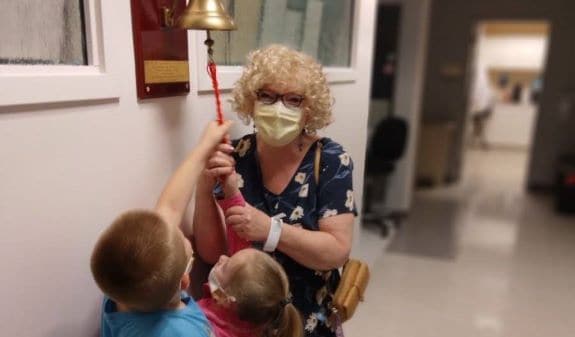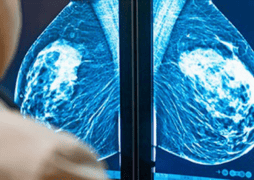Every day, many things in our environment can affect our health. When the health impact is immediate, the effects can be easy to see. For example, we all know that pollen can trigger allergies. Because breast cancer develops over a period of time, these relationships are not always obvious. This can cause us to wonder whether things in our neighborhoods such as power lines or pesticides impact our breast cancer risk. Looking at the scientific evidence can help us understand whether these exposures affect our risk.
How might power lines affect breast cancer risk?
Researchers have studied many possible environmental sources of breast cancer risk. One well-studied exposure is electric and magnetic fields (EMF) (also called non-ionizing radiation). We are exposed to natural and man-made sources of EMF every day. The earth’s magnetic field and electricity in the air during a storm are natural sources of EMF. Most man-made sources (such as power lines, electrical wiring and household appliances) have much lower levels of EMF than natural sources [1]. Also, we are shielded from most of the electric fields from man-made sources by the materials that cover them. Magnetic fields, whether natural or man-made, lose their strength the farther away we are from them [2].
Although the levels of EMF we are exposed to every day are very low, many research studies have examined a possible link between EMF and breast cancer risk.
How can we study whether EMF affects breast cancer?
There are several ways for researchers to study EMF. Certain jobs expose workers to higher levels of EMF than others. Researchers can compare breast cancer rates in these workers to those in the general population. If EMF increased risk, we would expect to see higher rates of breast cancer in the workers exposed to higher levels of EMF.
Even if we know there is a power line near our home, it might be difficult for us to measure how much EMF exposure we have in our homes. However, researchers can use special equipment designed to measure EMF. Breast cancer rates among people living in homes with higher measured levels of EMF can then be compared to rates among people living in homes with lower levels.
A third way researchers study EMF is to measure how far away people live from major power lines and use this as a rough estimate of exposure. They can then compare the rates of breast cancer among those who live near power lines to the rates of people who live far away.
What does the research show?
Overall, studies show no link between EMF exposure and breast cancer [3-4]. The combined results of 15 studies (including data on more than 24,000 women with breast cancer) found no increase in risk among women exposed to higher levels of EMF at work or in the home compared to women exposed to lower levels [4]. Findings from individual studies include:
- No excess breast cancer risk among women with jobs that expose them to high levels of EMF, such as radio and telegraph operators, utility workers, factory workers and seamstresses [5-10]
- No increase in breast cancer risk among women who live close to power lines compared to women who live far from power lines [6, 11-13]
- No increase in breast cancer risk among women who lived in homes with higher EMF levels (as measured by a device in the home) compared to women who lived in homes with lower levels [14]
- No increase in breast cancer risk among women who use electric blankets [15]
In 1997, the National Research Council concluded that exposure to EMF was not harmful to humans and that there was no solid evidence linking EMF to cancer [16]. Although studies continue to explore the health effects of EMF, it does not appear that EMF exposure, including living near a power line, impacts breast cancer risk.
How might pesticides affect breast cancer risk?
Organochlorines (or-GAN-oh-KLOR-eens) are a group of chemicals commonly used in pesticides. They are of special interest to researchers because they have some estrogen-like qualities. Higher levels of estrogen in the blood are linked to an increased risk of breast cancer. For this reason, many studies have looked at whether exposure to these chemicals might be linked to breast cancer.
How do we study pesticide exposures?
There are several ways researchers can study pesticide exposure. Farmers and pest control workers are exposed to higher levels of pesticides than those who simply use pesticides to help their lawns or gardens grow. If exposure to high levels of pesticides increased the risk of breast cancer, then we would expect to see higher rates of breast cancer in these workers.
For those people who do not work with pesticides, it can be hard to measure exposure. In general, self-report is not a reliable way to measure pesticide exposure. One way to study pesticide exposure without relying on a person’s memory is to look at the levels of certain pesticide chemicals in a person’s blood. Researchers can then compare breast cancer rates among those with higher blood levels of the chemical to those with lower levels.
What does the research show?
Farmers and pest control workers are exposed to more pesticides than others. Since 1993, the National Cancer Institute’s Agricultural Health Study has been studying pesticide use and the health of these workers. Findings from this study have shown [17-19]:
- No excess breast cancer risk among farmers, their wives, nursery workers or pest control workers
- No excess breast cancer risk among women who applied pesticides (although some excess risk among those who did not wear protective clothing)
Findings from studies looking at blood levels of chemicals are more reliable than reports that self-report of household exposure to pesticides. Many studies have found:
- No increase in breast cancer risk among women with higher blood levels of organochlorines compared to women with lower levels [20-29].
Overall, workers exposed to pesticides and women exposed to organochlorines do not appear to have an increased risk of breast cancer. However, according to Dr. Melissa Bondy, an epidemiologist at the University of Texas MD Anderson Cancer Center, the timing of the exposure to pesticides is an important area for future research. “Most studies have looked at pesticide exposure during adulthood, but our bodies process some chemicals differently when we are young and whether pesticide exposure early in life plays a role in breast cancer risk should also be studied.”
Conclusions
Researchers continue to study everyday environmental exposures that may be linked to breast cancer. The scientific evidence to date shows no link between EMF exposure from sources such as power lines and breast cancer risk as well as no link between organochlorines and breast cancer risk.
Studies of farmers and pest control workers do not suggest a link between pesticides and breast cancer risk. However, for many chemicals found in pesticides, we have limited, if any, data looking at possible links to breast cancer [30]. More research is needed to know whether or not these chemicals are related to breast cancer.
Future research
In the United States, government and non-government health organizations have begun efforts to set research priorities for exposures such as EMF and pesticides and breast cancer. The National Institute of Environmental Health Sciences and the National Institutes of Health established a committee of experts to set a research agenda on environmental factors (as well as genetic factors) that may be related to breast cancer. The Institute of Medicine, a non-government health agency, with support from Susan G. Komen for the Cure has established a Committee on Breast Cancer and the Environment to summarize the evidence to date on a broad range of environmental factors and breast cancer. The full IOM report is expected to be available to the public in the fall of 2011. The findings from these committees will help guide future research.
References
1. World Health Organization, International Agency for Research on Cancer (IARC). IARC Monographs on the Evaluation of Carcinogenic Risks to Humans – Volume 80: Non-Ionizing Radiation, Part 1. Static and extremely low-frequency (ELF) electric and magnetic fields. Lyon, France: International Agency for Research on Cancer, 2002.
2. National Cancer Institute. Magnetic Field Exposure and Cancer: Questions and answers. http://www.cancer.gov/cancertopics/factsheet/Risk/magnetic-fields, 2005.
3. Caplan LS, Schoenfeld ER, O’Leary ES, Leske MC. Breast cancer and electromagnetic fields–a review. Ann Epidemiol. 10(1):31-44, 2000.
4. Chen C, Ma X, Zhong M, Yu Z. Extremely low-frequency electromagnetic fields exposure and female breast cancer risk: a meta-analysis based on 24,338 cases and 60,628 controls. Breast Cancer Res Treat. 123(2):569-76, 2010.
5. Guénel P, Raskmark P, Andersen JB, Lynge E. Incidence of cancer in persons with occupational exposure to electromagnetic fields in Denmark. Br J Ind Med. 50(8):758-64, 1993.
6. Forssén UM, Feychting M, Rutqvist LE, Floderus B, Ahlbom A. Occupational and residential magnetic field exposure and breast cancer in females. Epidemiology. 11(1):24-9, 2000.
7. Kliukiene J, Tynes T, Anderson A. Follow-up of radio and telegraph operators with exposure to electromagnetic fields and risk of breast cancer. Eur J Cancer Prev. 12(4):301-7, 2003.
8. Kliukienne J, Tynes T, and Andersen A. Residential and occupational exposure to 50-Hz magnetic fields and breast cancer in women: A population-based study. 159(9):852-61, 2004.
9. Ray RM, Gao DL, Li W, et al. Occupational exposures and breast cancer among women textile workers in Shanghai. Epidemiology.18(3):383-92, 2007.
10. Johansen C, Raaschou Nielsen O, Olsen JH, Schüz J. Risk for leukaemia and brain and breast cancer among Danish utility workers: a second follow-up. Occup Environ Med. 64(11):782-4, 2007.
11. Verkasalo PK, Pukkala E, Kaprio J, Heikkilä KV, Koskenvuo M. Magnetic fields of high voltage power lines and risk of cancer in Finnish adults: nationwide cohort study. BMJ. 313(7064):1047-51, 1996.
12. Feychting M, Forssén U, Rutqvist LE, Ahlbom A. Magnetic fields and breast cancer in Swedish adults residing near high-voltage power lines. Epidemiology. 9(4):392-7, 1998
13. London SJ, Pogoda JM, Hwang KL, et al. Residential magnetic field exposure and breast cancer risk: a nested case-control study from a multiethnic cohort in Los Angeles County, California. Am J Epidemiol. 158(10):969-80, 2003.
14. Schoenfeld ER, O’Leary ES, Henderson K, et al. for the EMF and Breast Cancer on Long Island Study Group. Electromagnetic fields and breast cancer on Long Island: a case-control study. Am J Epidemiol. 158(1):47-58, 2003.
15. Laden F, Neas LM, Tolbert PE, et al. Electric blanket use and breast cancer in the Nurses’ Health Study. Am J Epidemiol. 152(1):41-9, 2000.
16. Committee on the Possible Effects of Electromagnetic Fields and Biologic Systems, Board on Radiation Effects Research, Commission on Life Sciences, National Research Council. Possible Health Effects of Exposure to Residential Electric and Magnetic Fields. Washington, D.C.: National Academy Press, 1997.
17. Duell EJ, Millikan RC, Savitz DA, et al. A population-based case-control study of farming and breast cancer in North Carolina. Epidemiology. 11(5):523-31, 2000.
18. Alavanja MC, Sandler DP, Lynch CF, et al. Cancer incidence in the agricultural health study. Scand J Work Environ Health. 31 Suppl 1:39-45, 2005.
19. Engel LS, Hill DA, Hoppin JA, et al. Pesticide use and breast cancer risk among farmers’ wives in the agricultural health study. Am J Epidemiol. 161(2):121-35, 2005.
20. Hoyer AP, Grandjean P, Jorgensen T, et al. Organochlorine exposure and risk of breast cancer. Lancet. 352(9143):1816-20, 1998.
21. Helzlsouer KJ, Alberg AJ, Huang HY, et al. Serum concentrations of organochlorine compounds and the subsequent development of breast cancer. Cancer Epidemiol Biomarkers Prev. 8(6):525-32, 1999.
22. Millikan R, De Voto E, Duell EJ, et al. Dichlorophenyldichloroethene, polychlorinated biphenyls, and breast cancer among African-American and white women in North Carolina. Cancer Epidemiol Biomarkers Prev. 9:1233-1240, 2000.
23. Hoyer AP, Jorgensen T, Rank F, and Grandjean P. Organochlorine exposures influence on breast cancer risk and survival according to estrogen receptor status: a Danish cohort-nested case-control study. BMC Cancer. 1(1):8, 2001.
24. Laden F, Collman G, Iwamoto K, et al. 1,1-Dichloro-2,2-bis(p-chlorophenyl)ethylene and polychlorinated biphenyls and breast cancer: combined analysis of five U.S. studies. J Natl Cancer Inst. 93(10):768-76, 2001.
25. Laden F, Hankinson SE, Wolff MS, et al. Plasma organochlorine levels and the risk of breast cancer: an extended follow-up in the Nurses’ Health Study. Int J Cancer. 91(4):568-74, 2001.
26. Gammon MD, Wolff MS, Neugut AI, et al. Environmental toxins and breast cancer on Long Island. II. Organochlorine compound levels in blood. Cancer Epidemiol Biomarkers Prev. 11(8):686-97, 2002.
27. Lopez-Cervantes M, Torres-Sanchez L, Tobias A, Lopez-Carrillo L. Dichlorodiphenyldichloroethane burden and breast cancer risk: a meta-analysis of the epidemiologic evidence. Environ Health Perspect. 112(2):207-14, 2004.
28. Raaschou-Nielsen O, Pavuk M, LeBlanc A, et al. Adipose organochlorine concentrations and risk of breast cancer among postmenopausal Danish women. Cancer Epidemiol Biomarkers Prev. 14(1):67-74, 2005.
29. Iwasaki M, Inoue M, Sasazuki S, et al. for the Japan Public Health Center-based Prospective Study Group. Plasma organochlorine levels and subsequent risk of breast cancer among Japanese women: a nested case-control study. Sci Total Environ. 402(2-3):176-83, 2008.
30. World Health Organization, International Agency for Research on Cancer (IARC). IARC Monographs on the Evaluation of Carcinogenic Risks to Humans – Volume 30: Miscellaneous Pesticides. Lyon, France: International Agency for Research on Cancer, 1998.



